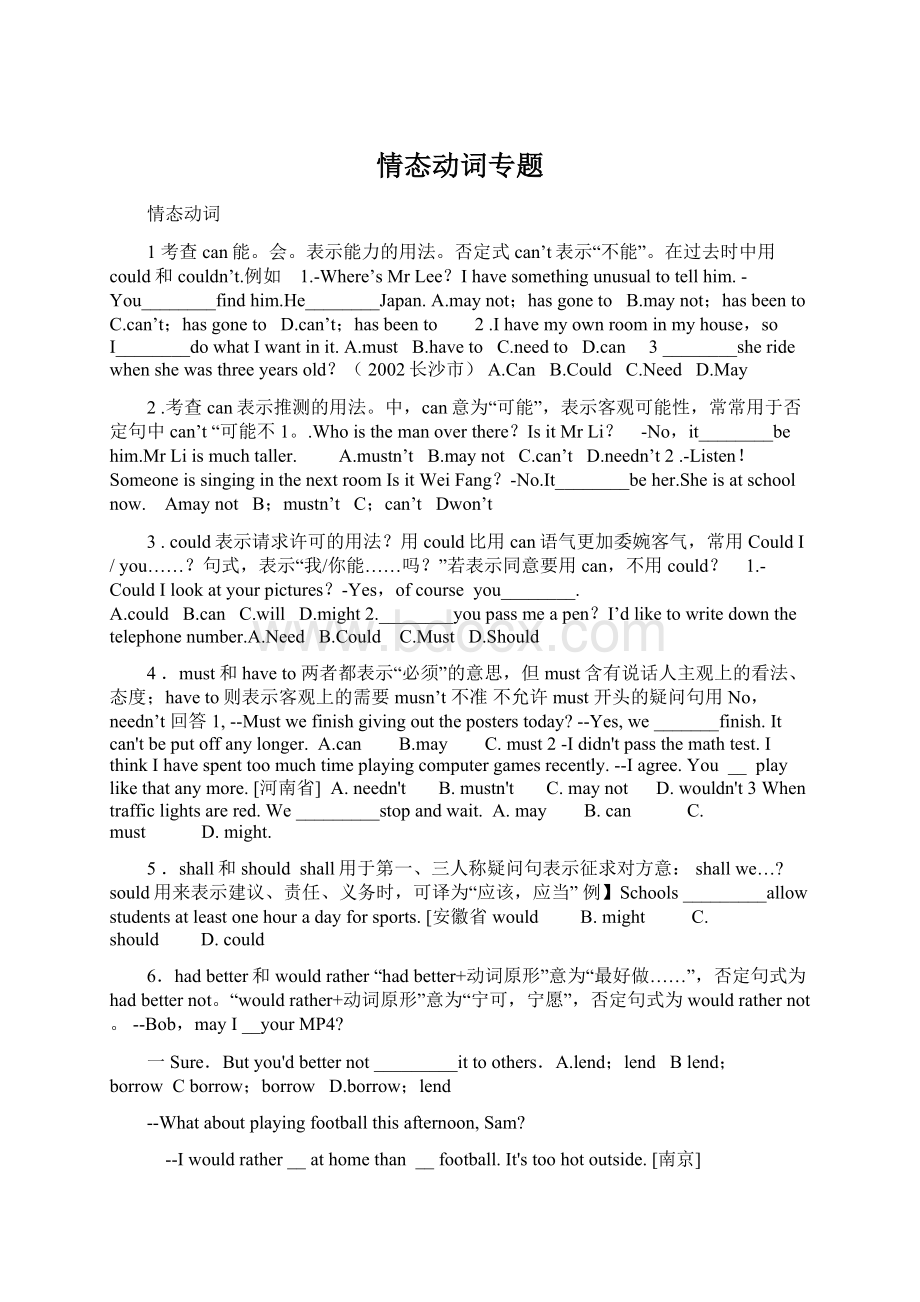情态动词专题.docx
《情态动词专题.docx》由会员分享,可在线阅读,更多相关《情态动词专题.docx(11页珍藏版)》请在冰豆网上搜索。

情态动词专题
情态动词
1考查can能。
会。
表示能力的用法。
否定式can’t表示“不能”。
在过去时中用could和couldn’t.例如 1.-Where’sMrLee?
Ihavesomethingunusualtotellhim.-You________findhim.He________Japan.A.maynot;hasgoneto B.maynot;hasbeentoC.can’t;hasgoneto D.can’t;hasbeento 2.Ihavemyownroominmyhouse,soI________dowhatIwantinit.A.must B.haveto C.needto D.can 3________sheridewhenshewasthreeyearsold?
(2002长沙市)A.Can B.Could C.Need D.May
2.考查can表示推测的用法。
中,can意为“可能”,表示客观可能性,常常用于否定句中can’t“可能不1。
.Whoisthemanoverthere?
IsitMrLi?
-No,it________behim.MrLiismuchtaller. A.mustn’t B.maynot C.can’t D.needn’t2.-Listen!
SomeoneissinginginthenextroomIsitWeiFang?
-No.It________beher.Sheisatschoolnow. Amaynot B;mustn’t C;can’t Dwon’t
3.could表示请求许可的用法?
用could比用can语气更加委婉客气,常用CouldI/you……?
句式,表示“我/你能……吗?
”若表示同意要用can,不用could?
1.-CouldIlookatyourpictures?
-Yes,ofcourseyou________.A.could B.can C.will D.might2.________youpassmeapen?
I’dliketowritedownthetelephonenumber.A.Need B.Could C.Must D.Should
4.must和haveto两者都表示“必须”的意思,但must含有说话人主观上的看法、态度;haveto则表示客观上的需要musn’t不准不允许must开头的疑问句用No,needn’t回答1,--Mustwefinishgivingouttheposterstoday?
--Yes,we_______finish.Itcan'tbeputoffanylonger.A.can B.may C.must2-Ididn'tpassthemathtest.IthinkIhavespenttoomuchtimeplayingcomputergamesrecently.--Iagree.You __ playlikethatanymore.[河南省]A.needn't B.mustn't C.maynot D.wouldn't3Whentrafficlightsarered.We_________stopandwait.A.may B.can C.must D.might.
5.shall和shouldshall用于第一、三人称疑问句表示征求对方意:
shallwe…?
sould用来表示建议、责任、义务时,可译为“应该,应当”例】Schools_________allowstudentsatleastonehouradayforsports.[安徽省would B.might C.should D.could
6.hadbetter和wouldrather“hadbetter+动词原形”意为“最好做……”,否定句式为hadbetternot。
“wouldrather+动词原形”意为“宁可,宁愿”,否定句式为wouldrathernot。
--Bob,mayI__yourMP4?
一Sure.Butyou'dbetternot_________ittoothers.A.lend;lend Blend;borrow Cborrow;borrow D.borrow;lend
--Whataboutplayingfootballthisafternoon,Sam?
--Iwouldrather__athomethan __football.It'stoohotoutside.[南京]
A.stay;playing B.stay;play C.tostay;toplay D.tostay;playing
[答案]:
A。
[解析]本题考查了wouldrather的固定短语的应用。
译文为:
萨姆,今天下午出去打球怎么样?
和踢足球相比,我宁愿呆在家里,外面太热。
WouldratherdoAthandoB和做B比起来,宁愿做A。
5.usedto
“usedto+动词原形”表示“过去常常做某事”或表示过去的一种惯常状态。
【考例】Heusedto________inthesun,butnowheisusedto atnight.[兰州]
A.read,read B.reading,read C.read,reading D.reading,reading
[答案]:
C。
[解析]考查固定结构的用法。
Used后接动词不定时,beusedto后接动名词。
故选C。
6.need和dare
You________doitifyoureallydon'twantto.[昆明市]
A.needn't B.mustn't C.can't D.couldn't
[答案]A。
[解析]考查情态动词。
本题应由句意人手破解。
如果你不想做的话,你“没有必要”做它,所以正确答案为A项。
--MayIdotherestoftheworktomorrow?
--Yea,ofcourse.You___________finishittoday.[成都市]
A.must B.mustn't C.needn't
[答案]C。
[解析]思路分析:
根据句意可知,needn’t不必。
二、考查情态动词表推测的用法
1.对现在或将来的推测用“情态动词+动词原形”。
肯定的推测一般用must,should,may(might)或can(could),其中,must的语气最强。
意为“肯定”、“准是”、“想必是”;should的语气次之,意为“很可能”、“应该”,指按常理推测;may(migt),can(could)的语气最弱,意为“有时会”、“也许”、“可能”。
否定推测分为两种情况:
语气不很肯定时,常用may/might/couldnot,意为“可能不”、“也许不”;否定语气较强时,则用can't,意为“根本不可能”、“一定不能”,表示惊异、怀疑的感情色彩。
【考例】You________betiredafterworkingforeighthourswithoutarest.[广东省]
A.can B.may C.must D.need
[答案]C。
[解析]本题考查情态动词must,can,may,need的区别。
本题由题意人手,“你工作了八个小时没有休息肯定很累。
”情态动词must在此表示肯定的推测。
一Lookattheboyrunningontheground.IsitDavis?
——It____behim.Isawhimgototheteacher'sofficejustnow.[黄冈市]
A.must Bcan't C.could D.might
[答案]B。
[解析]考查情态动词。
表推测时否定句中用can't。
表示“不可能”,因为他已经去了老师的办公室。
【语法回顾】
1情态动词的语法特征
1)情态动词不能表示正在发生或已经发生的事情,只表示期待或估计某事的发生。
2)情态动词除ought和have外,后面只能接不带to的不定式。
3)情态动词没有人称,数的变化,即情态动词第三人称单数不加-s。
4)情态动词没有非谓语形式,即没有不定式,分词,等形式。
常见的情态动词有:
can(could),may(might),must,shall(should),will(would),dare(dared),need等,另外,haveto、hadbetter也当作情态动词使用。
情态动词后面必须加动词的原形。
can和beableto
1)can/could表示能力;可能(过去时用could),只用于现在式和过去式(could)。
beableto可以用于各种时态。
例如:
Theywillbeabletotellyouthenewssoon.他很快就能告诉你消息了。
2)只用beableto的情况:
a.位于助动词后。
b.情态动词后。
c.表示过去某时刻动作时。
d.用于句首表示条件。
e.表示成功地做了某事时,用was/wereableto,不能用could。
例如:
HewasabletofleeEuropebeforethewarbrokeout.=HemanagedtofleeEuropebeforethewarbrokeout.
他在战争爆发之前逃离欧洲。
注意:
could有时不表示时态
1)提出委婉的请求,(注意在回答中不可用could)。
例如:
---CouldIhavethetelevisionon?
我能看电视吗?
---Yes,youcan./No,youcan't.可以/不可以。
2)在否定句、疑问句中表示推测或怀疑。
例如:
Hecouldn'tbeabadman.他不大可能是坏人。
may和mightwww.zk5u.co
1)表示允许或请求;表示没有把握的推测;may放在句首,表示祝愿。
例如:
MayGodblessyou!
愿上帝保佑你!
Hemightbeathome.他可能在家。
注意:
might表示推测时,不表示时态,只是可能性比may小。
2)成语:
may/mightaswell,后面接不带to的不定式,意为"不妨"。
例如:
Ifthatisthecase,wemayaswelltry.如果情况确实如此,我们不妨试一试。
haveto和must
1) 两词都是'必须'的意思,haveto表示客观的需要,must表示说话人主观上的看法,既主观上的必要。
例如:
Mybrotherwasveryill,soIhadtocallthedoctorinthemiddleofthenight. 弟弟病得很厉害,我只得半夜里把医生请来。
(客观上需要做这件事)
Hesaidthattheymustworkhard.他说他们必须努力工作。
(主观上要做这件事)
2) haveto有人称、数、时态的变化,而must只有一种形式。
但must可用于间接引语中表示过去的必要或义务。
例如:
Hehadtolookafterhissisteryesterday.他昨晚只得照顾他姐姐。
3)否定结构中:
don'thaveto表示"不必",mustn't表示"禁止"。
例如:
Youdon'thavetotellhimaboutit. 你不一定要把此事告诉他。
Youmustn'ttellhimaboutit. 你不得把这件事告诉他。
must表示推测
1)must用在肯定句中表示较有把握的推测,意为"一定"。
2)must表对现在的状态或现在正发生的事情的推测时,must后面通常接系动词be的原形或行为动词的进行式。
例如:
Youhaveworkedhardallday.Youmustbetired.你辛苦干一整天,一定累了。
(对现在情况的推测判断)
Hemustbeworkinginhisoffice.他一定在办公室工作呢。
比较:
Hemustbestayingthere.他现在肯定在那里。
Hemuststaythere.他必须呆在那。
3)must表示对已发生的事情的推测时,must要接完成式。
例如:
Ididn'thearthephone.Imusthavebeenasleep. 我刚才没有听到电话,我想必是睡着了。
4)must表示对过去某时正发生的事情的推测,must后面要接不定式的完成进行式。
例如:
---Whydidn'tyouanswermyphonecall?
为何不接我的电话?
---Well,Imusthavebeensleeping,soIdidn'thearit.唉,肯定在睡觉,所以没有听见。
5)否定推测用can't。
例如:
IfTomdidn'tleavehereuntilfiveo'clock,hecan'tbehomeyet. 如果汤姆五点才离开这儿,他此时一定还未到家。
表示推测的用法
can,could,may,might,must皆可表示推测,其用法如下:
1)情态动词+动词原形,表示对现在或将来的情况的推测,此时动词通常为系动词。
例如:
Idon'tknowwheresheis,shemaybeinWuhan.我不知道她在哪儿,可能在武汉。
2)情态动词+动词现在进行时,表示对现在或将来正在进行的情况进行推测。
例如:
Atthismoment,ourteachermustbecorrectingourexampapers.这时,想必我们老师正在批改试卷。
should和oughtto
除了上述的用法,两者还可表示"想必一定,按理应该"的意思。
例如:
Ioughttobeabletoliveonmysalary.靠我的薪水,想必也能维持了。
Itoughttobereadynow.想必现在准备好了吧。
Theyshouldbetherebynow,Ithink.现在他们该到那儿了。
Thepoemsshouldbeoutinamonthatmost.诗集估计最多还有一个月就要出版了。
hadbetter表示"最好",相当于一个助动词,它只有一种形式,它后面要跟动词原形。
例如:
Itisprettycold.You'dbetterputonmycoat.天相当冷。
你最好穿上我的外套。
She'dbetternotplaywiththedog.她最好不要玩耍那条狗。
wouldrather表示"宁愿"www.zk5u.co
wouldratherdo
wouldrathernotdo
wouldrather…than… 宁愿…而不愿。
还有wouldsooner,hadrather,hadsooner都表示"宁愿"、"宁可"的意思。
例如:
IfIhaveachoice,Ihadsoonernotcontinuemystudiesatthisschool.如果有选择的余地,我宁可辍学离开这个学校。
Iwouldratherstayherethangohome.=Iwouldstayhereratherthangohome.我宁愿呆在这儿,而不愿回家。
will和would
注意:
1)wouldlike;wouldliketodo=wantto想要,为固定搭配。
例如:
Wouldyouliketogowithme?
想和我一块去吗?
2)Willyou…?
Wouldyoulike…?
表示肯定含义的请求劝说时,疑问句中一般用some,而不是any。
例如:
Wouldyoulikesomecake?
吃点蛋糕吧。
3)否定结构中用will,一般不用would,won'tyou是一种委婉语气。
Won'tyousitdown?
你不坐下吗?
情态动词的回答方式
问句
肯定回答
否定回答
Needyou…?
Yes,Imust.
No,Ineedn't
Mustyou…?
No,Idon'thaveto.
带to的情态动词
带to的情态动词有四个:
oughtto,haveto,usedto,beto,如加上havegotto(=must),beableto,为六个。
它们的疑问、否定形式应予以注意:
Dotheyhavetopaytheirbillbeforetheendofthemonth?
他们必须在月底前付帐单吗?
Shedidn'tusetoplaytennisbeforeshewasfourteen.在她十四岁前,她不会打网球。
Yououghtnottohavetoldherallaboutit.你不应该告诉他所有这件事。
Oughthetoseeaheartspecialistatonce.?
oughtto本身作为情态动词使用。
其他的词作为实义动词使用,变疑问,否定时,须有do等助动词协助。
need和dare
这两词既可做实义动词用,又可做情态动词用。
作为情态动词,两者都只能用于疑问句,否定句和条件句。
need
作实义动词时后面的不定式必须带to,而dare作实义动词用时,后面的to时常可以被省略。
1)实义动词:
need(需要,要求) need+n./todosth
2)情态动词:
need,只用原形need后加do,否定形式为neednot。
例如:
Needyougoyet?
你要走了吗?
Yes,Imust./No,Ineedn't.是的,我要走了/不,不急着走。
语法过关
1.— ______Ifillinthecheck-informrightnow,sir?
—No,youneedn’t.Youcancompleteitthisafternoon.
A.May B.Can C.Would D.Must
2.—CouldIgotothemoviethisweekend,Dad?
一Yes,you____.Butyouhavetocomebackbeforenine.
A.shall B.must C.need D.can
3.You playwithfire,Tom.It'sdangerous.
A.needn't B.maynot C.mustn't D.wouldn't
4.Asweknow,fish___dieoutof water.
A.may B.isgoingto C.can D.will
5.—ShallIbooksomeseatsfortheconcert?
—_____________.I’vealreadydonethat.
A.Yes,youmay B.No,youmustn’t C.No,youneedn’t D.I’drathernot
6.—IthinkMissGaomustbeinthelibrary.Shesaidshewouldgothere.
—No,she________bethere.I'vejustseenherthere.
A.can't B.mustn't C.needn't D.wouldn't
7.You______worryabouthim.Hewillgetwellsoon.
A.needn't B.can't C.mustn't D.maynot
8.Schools_____allowstudentsatleastonehouradayforsports.
A.would B.might C.should D.could
9.You___openthedoorbeforethetraingetsintothestation.
A.don'thaveto B.mustn't C.needn't D.maynot
10.—Iwastoldtobeherebeforeeight.
—Oh,you— .I’msorryfornottellingyouthatwehavechangedtheplan.
A.must B.can’t C.may D.needn’t
11.—MayItakethisbookoutofthereadingroom?
— _____ .Pleasereadithere.
A.Certainly B.No,youneedn’t C.No,youmustn’t
12.—Who’sthatwomanwithAnn?
—I’mnotsure. It _____ be hermoth